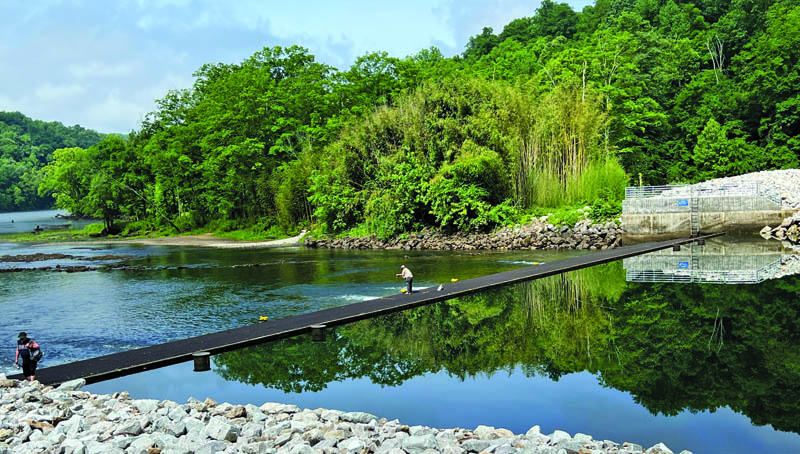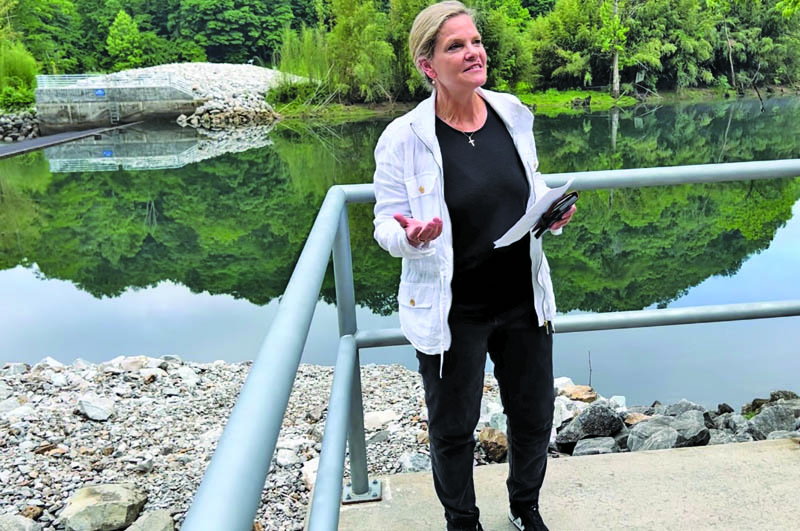TVA reopens weir dam area on Clinch
The popular trout-fishing area at the weir dam on the Clinch River just below Norris Dam has been officially reopened to recreational use after nearly a year of rehabilitation work to the connected Hibbs Island.
The reopening was marked by a recent media event at the site by the Tennessee Valley Authority.
TVA spent about $1 million and brought in 3,200 tons of rock, underpinned by 1,299 cubic yards of soil, to build a 217-foot-long berm across the island at the Norris weir, which is about a mile downstream from Norris Dam.
Speakers at the event, held in an overlook just above the little dam, included James Everett, TVA’s general manager of river management, Anderson County Mayor Terry Frank, Jim Habera of the Tennessee Wildlife Resources Agency, Trout Unlimited Clinch River Chapter President Bob Stephan, and Jeff Ogden, TVA’s program manager for reservoir release improvements
The new berm, highly visible because of its large chunks of white rock, is designed to “protect the island from extensive erosion, save the existing re-regulating weir, guarantee enough environmental flow (a term describing the quantity, timing, and quality necessary to sustain river ecosystems) below the dam to protect aquatic life downstream, and preserve an important recreation spot for anglers,” the federal agency reported.
Personnel from TVA’s Engineering Laboratory in Norris conducted the fieldwork for this project, after noting that floodwater had been running over the island instead of through the river channels on each side of it, causing extension erosion damage to the island.
A weir or low-head dam is a barrier across the width of a river that alters the flow of water and usually results in a change in the height of the river level. Weirs are also used to control the flow of water for outlets of lakes, ponds, and reservoirs, TVA said.
At this weir, the river is held back into a low, calm pond area while water flows through, creating a torrid stream below the small dam that creates a perfect habitat for trout.
The dam and nearby parking area were closed and inaccessible to anglers and other guests during the year, but on Friday there were people trout fishing while standing on the little dam, casting into the swirling waters below.
Hibbs Island itself is closed to the public.
TVA built the weir in 1995 to control flow of the Clinch River when water is not being released at Norris Dam to generate power, the agency said.
“This minimum flow – meaning quantity, timing and quality of water – is necessary to sustain river ecosystems and aquatic life for several miles,” TVA said. “And healthy rivers and aquatic life are paramount for recreation such as kayaking and fishing.
“Additionally, the weir helps control flooding and promotes public safety.”
TVA said that over several years, high-flow releases from Norris Dam “resulted in high river currents, which, in turn, caused part of the 10.6-acre island to erode and deteriorate. The deterioration of the island could have allowed water releases from the dam to pass through the area between the weir sections – thus destabilizing the weirs.”
The agency said that its rehabilitation efforts at Hibbs Island, along with other river stewardship projects, “align with TVA’s mission to serve the people of the Valley Region – helping the environment thrive and supporting the economy through activities such as ecotourism.”




